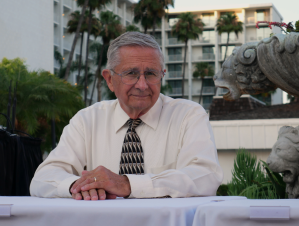 Tomorrow is the one week anniversary of a sudden and unexpected death that has rocked the gifted community and has brought a deluge of memorial messages that the writers surely hope will assuage their own shock and grief, and comfort both Jim Webb’s family and all those who have benefited over the last 37 years from the work that he (and SENG) did to bring attention to the needs of gifted children and families. In addition, of course, there is the plethora of books that he published in the field, from the first days of Ohio Psychological Publishing (initial publisher—1982—of Guiding the Gifted Child) to the era of Great Potential Press.
Tomorrow is the one week anniversary of a sudden and unexpected death that has rocked the gifted community and has brought a deluge of memorial messages that the writers surely hope will assuage their own shock and grief, and comfort both Jim Webb’s family and all those who have benefited over the last 37 years from the work that he (and SENG) did to bring attention to the needs of gifted children and families. In addition, of course, there is the plethora of books that he published in the field, from the first days of Ohio Psychological Publishing (initial publisher—1982—of Guiding the Gifted Child) to the era of Great Potential Press.
As I have read those messages, I have been aware that the Jim Webb those writers describe is not the Jim Webb I met in 1981, nor the Jim Webb I knew during the approximately 20 years thereafter during which he and I and Elizabeth (Betty) Meckstroth discussed and sometimes attempted to write a second edition of Guiding. We never managed it because it turned out that she and I, by then both members of the Columbus Group, no longer were in agreement with what he wanted to say about giftedness. (When I was doing the writing part of Guiding, I found in his notes the statement that a gifted child was a child first and “gifted only secondarily.” so I called him up and explained that Betty and I did not agree with that statement. He acquiesced. The book’s theme became pretty much the opposite—giftedness, certainly extreme giftedness, is inborn.) Because our Guiding contract did not allow Jim to engage someone else to write the revision, the three of us finally gave up on revising it. After that his and my interactions dwindled to social events at various conferences, so I didn’t know him at all well in recent years.
But because I am among those in the gifted community who knew him “almost from the start,” I have been contacted to share for publication my thoughts about him and my feelings about his passing. I decided to write here instead. Of course, I was as shocked as anyone that he should leave the world so suddenly and so “young.” He was only 3 years older than I, so we are of the same “cohort” as it were. Too young, in other words! And I’m as aware as anyone of the enormous impact his work—his speaking and publishing, and the work of SENG—have had on the world’s understanding that the complex population of gifted kids, adults, elders and educators is of vital importance to humanity. I did post a couple of comments on the FB pages of others.
But the requests for comments, and the reading of what others have been posting in social media, got me to asking “who are we?”– we individual humans.  The profile photo on my own personal Facebook page is not one anyone except my family would recognize as me—I was a blond, pigtailed child of eight at the time it was taken. Who I was then was an “annoying” kid (according to some of my teachers—and maybe my parents, and probably my older siblings). There was no such thing as a gifted, much less a highly gifted kid in my world at the time.
The profile photo on my own personal Facebook page is not one anyone except my family would recognize as me—I was a blond, pigtailed child of eight at the time it was taken. Who I was then was an “annoying” kid (according to some of my teachers—and maybe my parents, and probably my older siblings). There was no such thing as a gifted, much less a highly gifted kid in my world at the time.
Back in the 70’s when Jane Piirto did her study of successful women writers, of which I was one by her study’s standards, as I was in the Directory of American Poets, and worked in the Poets in the Schools program, I actually claimed (because I believed) that I had “loved school.” I got good grades, after all. (psst: it’s called repression.)
It wasn’t until the conference in Nebraska to honor Leta Hollingworth (in 1989, seven years after the publication of Guiding!), when I heard Leta’s poem “The Lone Pine” in a documentary, that I confronted the very new truth that I had been a highly gifted child who loathed and despised school except for a very occasional teacher. (I think there were 5 or 6 between Kindergarten and college.) I could add that my teachers did not like me either, to put it sometimes mildly. I literally cried the whole second leg (Chicago to Albany) of my flight home from Nebraska and then wrote obsessively for six hours afterwards, uncovering a veritable dump truck load of painful memories. So it’s a tricky question. Who was I before and after that conference?
I wrote a great deal about parenting gifted kids before I ever knew I had been one—though my husband’s extreme giftedness had been unmasked when our son was identified. My mother-in-law explained the shocking truth that the one year of elementary school he remembered—when he got to ride a trolley to a special school (a school he thought was for “difficult” kids) was actually a pilot program for the highly gifted. I remember all too well his horror that he hadn’t accomplished more as an adult—he was “only” a theatre director with a Ph.D. after all. Who was he before and after?
I interacted with Jim regularly for years. When SENG conferences began I spoke at them. But when a friend of mine who headed a national organization that had financially supported one of them took me to dinner at the conference and asked me about stories he had heard from other speakers about Jim lowering contracted speaker fees at the last minute with a threat to take them off the schedule if they didn’t sign the new contract, I told him that it hadn’t bothered me because I had just corrected the amount on the contract to the amount I’d been promised, initialed it, and signed. He asked me further questions, and I answered truthfully with whatever facts I knew. The organization never again supported SENG and I was never again asked to speak at Jim’s conferences.
I was born in 1942 and grew up in a world where most women stayed at home and few professions were open even to bright and accomplished women. And I spent some time (5 years) in higher education, where my male office mate, with precisely the same credentials as mine, made one fifth more than I in salary. I wasn’t happy about it, but it was “the way things were.” There was a huge power imbalance in our world, we knew it, and we pretty much put up with it. When Jim promoted Guiding as his book, Betty and I used to call each other “Et” and “Al,” which was the most common representation (when we got any) of our participation. Once I even saw myself listed as the author only of the “Open Letter” chapter, https://welcometothedeepend.com/an-open-letter-updated/ which I had copyrighted in my name so that I could use it elsewhere, as above and in Out of Sync https://www.rfwp.com/book/out-of-sync-essays-on-giftedness. But I long ago forgave him. The book gave me my work with the gifted, for which I am enduringly grateful.
In this era of “#Me, too” I’ve sometimes been bothered when men who have had long and successful careers, sometimes doing important work for the common good, can essentially lose everything when it is revealed that they previously used their power in ways that are now recognized as inappropriate, sometimes decades ago, at a time when the whole culture turned a blind eye to their behavior. Except for actual crimes (and even some crimes have statutes of limitation) I wonder, in spite of those who want to insist on truth, whether it is just or fair to judge a person for “who they were then,” when it is at least possible and maybe probable that they are not that person any more. I know, the culture needs to truly change, but still…
In the many comments I have read about Jim’s kindness, his caring, his deep friendships and unstinting emotional support, I recognize that these people, many of them friends and colleagues, knew a more recent and very different person than I ever did. I honor their experiences because it is very, very easy for me to remember myself treating other people when I was younger in a way that would pretty much horrify me now. I would not wish to be thought of as that person today! In a world where caring and kindness, inclusion, deep listening, and efforts to understand those who disagree with us or have less power than we do are getting vanishingly rare, and desperately needed, I remind myself that we never, genuinely never, fully know someone, perhaps even ourselves, the only one whose mind we inhabit. So today I mourn the Jim Webb those people are mourning.
And having survived some terrible losses myself, I send deep and heartfelt condolences to Janet and his family!



